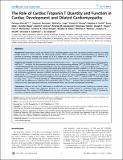| dc.contributor.author | Ahmad, Ferhaan | |
| dc.contributor.author | Banerjee, Sanjay K. | |
| dc.contributor.author | Lage, Michele L. | |
| dc.contributor.author | Huang, Xueyin N. | |
| dc.contributor.author | Saba, Samir | |
| dc.contributor.author | Rager, Jennifer | |
| dc.contributor.author | Janczewski, Andrzej M. | |
| dc.contributor.author | Tobita, Kimimasa | |
| dc.contributor.author | Tinney, Joseph P. | |
| dc.contributor.author | Moskowitz, Ivan P. | |
| dc.contributor.author | Keller, Bradley B. | |
| dc.contributor.author | Mathier, Michael A. | |
| dc.contributor.author | Shroff, Sanjeev G. | |
| dc.contributor.author | Smith, Stephen H. | |
| dc.contributor.author | Conner, David Atwater | |
| dc.contributor.author | Perez-Atayde, Antonio Rafael | |
| dc.contributor.author | Seidman, Christine Edry | |
| dc.contributor.author | Seidman, Jonathan G. | |
| dc.date.accessioned | 2010-12-09T20:51:18Z | |
| dc.date.issued | 2008 | |
| dc.identifier.citation | Ahmad, Ferhaan, Sanjay K. Banerjee, Michele L. Lage, Xueyin N. Huang, Stephen H. Smith, Samir Saba, Jennifer Rager, et al. 2008. The Role of cardiac troponin T quantity and function in cardiac development and dilated cardiomyopathy. PLoS ONE 3(7): e2642. | en_US |
| dc.identifier.issn | 1932-6203 | en_US |
| dc.identifier.uri | http://nrs.harvard.edu/urn-3:HUL.InstRepos:4621870 | |
| dc.description.abstract | Background: Hypertrophic (HCM) and dilated (DCM) cardiomyopathies result from sarcomeric protein mutations, including cardiac troponin T (cTnT, TNNT2). We determined whether TNNT2 mutations cause cardiomyopathies by altering cTnT function or quantity; whether the severity of DCM is related to the ratio of mutant to wildtype cTnT; whether Ca2+ desensitization occurs in DCM; and whether absence of cTnT impairs early embryonic cardiogenesis. Methods and Findings: We ablated Tnnt2 to produce heterozygous Tnnt2+/− mice, and crossbreeding produced homozygous null Tnnt2−/− embryos. We also generated transgenic mice overexpressing wildtype (TGWT) or DCM mutant (TGK210Δ) Tnnt2. Crossbreeding produced mice lacking one allele of Tnnt2, but carrying wildtype (Tnnt2+/−/TGWT) or mutant (Tnnt2+/−/TGK210Δ) transgenes. Tnnt2+/− mice relative to wildtype had significantly reduced transcript (0.82±0.06[SD] vs. 1.00±0.12 arbitrary units; p = 0.025), but not protein (1.01±0.20 vs. 1.00±0.13 arbitrary units; p = 0.44). Tnnt2+/− mice had normal hearts (histology, mass, left ventricular end diastolic diameter [LVEDD], fractional shortening [FS]). Moreover, whereas Tnnt2+/−/TGK210Δ mice had severe DCM, TGK210Δ mice had only mild DCM (FS 18±4 vs. 29±7%; p<0.01). The difference in severity of DCM may be attributable to a greater ratio of mutant to wildtype Tnnt2 transcript in Tnnt2+/−/TGK210Δ relative to TGK210Δ mice (2.42±0.08, p = 0.03). Tnnt2+/−/TGK210Δ muscle showed Ca2+ desensitization (pCa50 = 5.34±0.08 vs. 5.58±0.03 at sarcomere length 1.9 µm, p<0.01), but no difference in maximum force generation. Day 9.5 Tnnt2−/− embryos had normally looped hearts, but thin ventricular walls, large pericardial effusions, noncontractile hearts, and severely disorganized sarcomeres. Conclusions: Absence of one Tnnt2 allele leads to a mild deficit in transcript but not protein, leading to a normal cardiac phenotype. DCM results from abnormal function of a mutant protein, which is associated with myocyte Ca2+ desensitization. The severity of DCM depends on the ratio of mutant to wildtype Tnnt2 transcript. cTnT is essential for sarcomere formation, but normal embryonic heart looping occurs without contractile activity. | en_US |
| dc.language.iso | en_US | en_US |
| dc.publisher | Public Library of Science | en_US |
| dc.relation.isversionof | doi:10.1371/journal.pone.0002642 | en_US |
| dc.relation.hasversion | http://www.ncbi.nlm.nih.gov/pmc/articles/PMC2441440/pdf/ | en_US |
| dash.license | LAA | |
| dc.subject | genetics and genomics | en_US |
| dc.subject | disease models | en_US |
| dc.subject | genetics of disease | en_US |
| dc.subject | arrhythmias, electrophysiology, and pacing | en_US |
| dc.subject | heart failure | en_US |
| dc.subject | myopathies | en_US |
| dc.title | The Role of Cardiac Troponin T Quantity and Function in Cardiac Development and Dilated Cardiomyopathy | en_US |
| dc.type | Journal Article | en_US |
| dc.description.version | Version of Record | en_US |
| dc.relation.journal | PLoS ONE | en_US |
| dash.depositing.author | Conner, David Atwater | |
| dc.date.available | 2010-12-09T20:51:18Z | |
| dash.affiliation.other | HMS^Genetics | en_US |
| dc.identifier.doi | 10.1371/journal.pone.0002642 | * |
| dash.authorsordered | false | |
| dash.contributor.affiliated | Conner, David | |
| dash.contributor.affiliated | Seidman, Jonathan | |
| dash.contributor.affiliated | Perez-Atayde, Antonio | |
| dash.contributor.affiliated | Seidman, Christine | |


